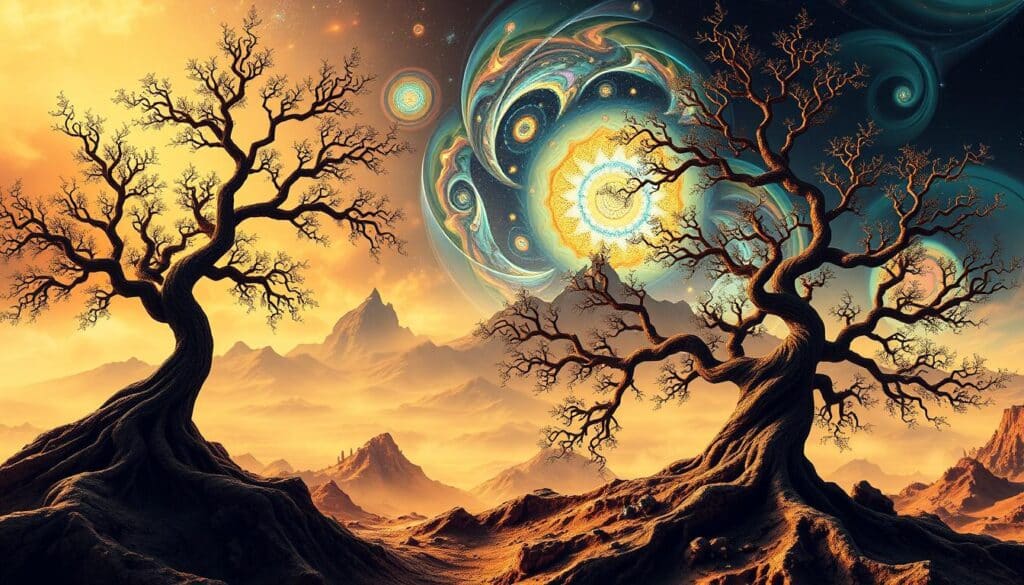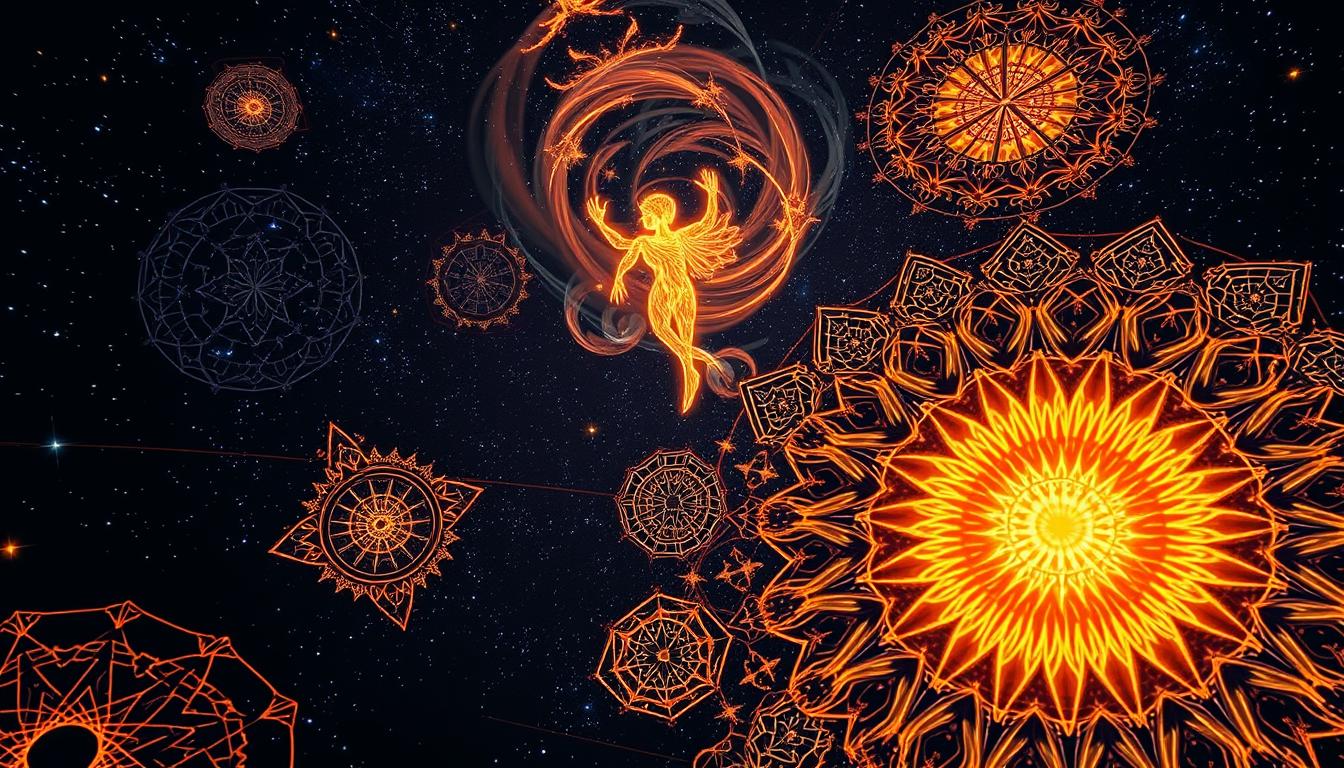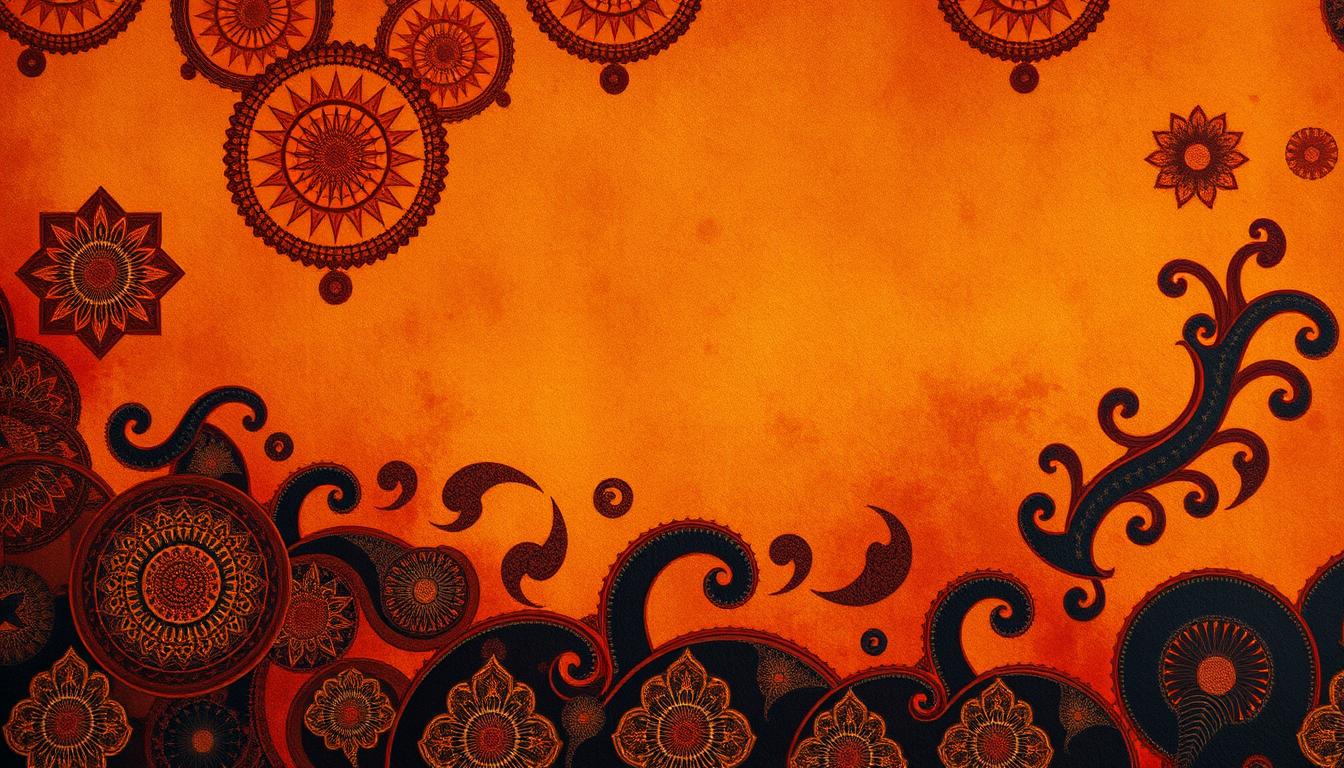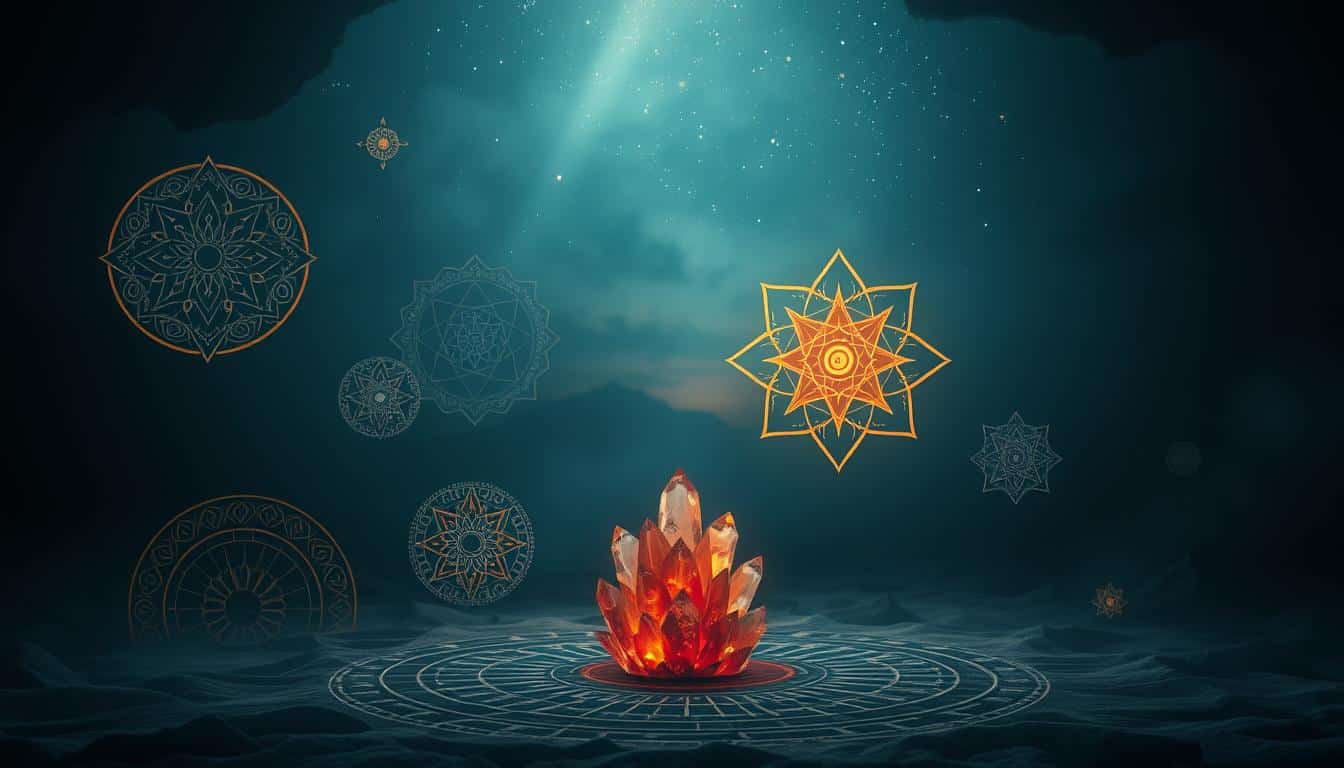Fractal patterns provide a unique way to look at how indigenous communities grow. They are found in nature and cultural designs. These patterns show us how communities live in harmony with their environment. By looking at fractals in indigenous cultures, we learn about their resilience and care for nature.
Studying these patterns helps us see how everything in a community is connected. It leads us to better ways to support sustainable growth. The mix of indigenous wisdom and fractal geometry gives us new insights into managing growth and keeping our planet healthy.
Introduction to Fractal Patterns
Fractal patterns are a captivating topic in various fields, like math and ecology. These patterns show self-similarity at different scales, sparking interest in both theory and practical uses. Studying fractals helps us grasp the complexity of nature and structures around us.
Fractals are more than just pretty patterns. They represent growth and sustainability, which are vital for indigenous communities. In many cultures, these patterns mirror the link between people, their environment, and social setups. They symbolize beliefs in harmony and balance.

By studying these patterns, we learn how indigenous communities have adapted and survived. They’ve held onto their culture while embracing changes. This knowledge encourages us to apply fractal ideas to modern-day sustainability efforts, boosting community development.
Understanding Fractals
Fractals are an exciting mix of art and math, showing amazing patterns that hint at nature’s deeper order. They are defined by their repeating patterns at different sizes, making them complex and widespread. This idea takes us beyond simple shapes, leading to new discoveries.
Definition of Fractals
Fractals are geometric shapes with complex patterns, no matter how closely you look. Zooming in on a fractal reveals the same patterns. This quality is not just for mathematicians; it also inspires artists and designers with its natural beauty and structure.
Historical Context of Fractal Geometry
The history of fractal geometry starts with mathematicians like Benoît Mandelbrot in the late 20th century. He showed how fractals bring a new perspective to mathematical shapes. Fractals have changed how we see natural phenomena and have impacted everything from coastline studies to market analysis, merging math with the real world beautifully.
Fractal Patterns in Nature
Natural fractals are found in many biological forms, showing nature’s intricate beauty. They range from how trees branch out to the way rivers flow. These patterns show the complex and efficient ways ecosystems work. Looking at these natural structures makes us appreciate ecological patterns more. They inspire us to practice sustainability.
Examples of Natural Fractals
You can see natural fractals in many places, like:
- The repetitive branching in plants like ferns and trees.
- The spiral shapes of seashells and pine cones.
- River networks with fractal-like branching.
These examples show how fractal geometry is used in nature. Each structure helps keep the ecosystem healthy. They show how everything in nature is connected, which is important for sustainability.
The Role of Fractal Structures in Ecosystems
Fractal structures are key in keeping ecological balance. They make sure resources are spread out well and help different species interact. This connection helps ecosystems stay strong and adapt to changes. Learning about these patterns helps communities make plans that respect nature. This promotes environmental sustainability.
Indigenous Knowledge and Fractals
Fractal designs are everywhere in indigenous cultures. They show a cultural connection to the environment. These patterns are not just for looks; they share a view of the world. This view links communities with nature. The designs show the wisdom in indigenous knowledge. This knowledge leads to ways of living that help communities stay strong and healthy.
Connection Between Culture and Fractal Design
Indigenous cultures use fractal design in their art, buildings, and ceremonies. They express their traditions with these complex patterns. Every design tells stories of nature guiding how people live. These links between culture and nature are key. They help find ways to meet environmental challenges.
Ron Eglash’s Research on African Fractals
Ron Eglash’s work points out how important fractals are in African cultures. His research shows that fractal designs are part of everyday life in many African communities. They appear in the layout of villages and in art. This use of fractals shows how indigenous knowledge works in real life. It explains how communities understand their social and physical world. Eglash’s findings also highlight how fractal design has been a part of community history and growth.
Fractal Patterns in Indigenous Architecture
Indigenous communities’ architectural styles show their cultural beliefs. Fractal designs are key, showing harmony, sustainability, and a bond with nature. They use recurring patterns in buildings, reflecting their values and traditions.
Designs Reflecting Cultural Beliefs
Indigenous architecture shows cultural beliefs through special designs. Fractal designs help these communities make structures that highlight balance and unity with nature. They often feature:
- Organic shapes that look like natural forms.
- Proportions that match local ecosystems.
- Materials taken responsibly from nature.
This way of building shows a close connection between man-made and natural worlds. It respects cultural teachings and practices handed down over generations.
Recursion and Scaling in Building Structures
Many indigenous styles use recursion, where small parts reflect the whole. This scaling makes buildings look better and work better. Examples are:
- Huts with layers, showing communal life.
- Spiraled roofs that help with rainwater.
- Pathways that mean community connections.
Indigenous architecture with fractal designs tells a story of cultural beliefs. It mixes traditions with modern buildings and cares for the environment. These designs remind us of the communities’ ties to their culture, land, and each other.
Urban Growth and Fractals
Urban growth and fractal patterns show a unique way spaces grow in indigenous areas. These patterns show the complex links between elements in urban spaces. Understanding them helps people know more about indigenous city planning. This leads to better, lasting development ways.
Fractal Urban Patterns in Indigenous Societies
Indigenous societies show fractal patterns in their cities. These reflect their history and culture. These patterns come from knowing the local area and what the community needs. They have some key features:
- Decentralized layouts that reflect diverse community functions.
- Integration of natural elements to enhance ecological resilience.
- Responsive designs that adapt to the evolving needs of the population.
Impact on Community Development
Knowing about fractal patterns in city growth helps communities. It guides urban planners to make plans that focus on lasting and fair systems. The main advantages are:
- Enhanced community engagement through culturally relevant planning.
- Improved resource management strategies that promote resilience.
- Flexible infrastructures that accommodate future growth and change.
Utilizing Fractal Patterns for Sustainable Indigenous Community Development
Using fractal patterns helps indigenous communities grow sustainably. These patterns, inspired by nature, let communities build in harmony with the environment. This way, they can make spaces that bring people together and respect nature.
When communities use fractal patterns in planning, they balance economic and cultural needs. This balance leads to new ways to support their lives and the environment. By embracing fractal designs, these communities can care for their surroundings and help both their people and nature.
This way of developing sustainably sets the stage for a stronger future. It combines indigenous knowledge with the power of fractal patterns. This helps both people and the planet thrive together.
Fractals in Agriculture and Land Use
Traditional farming methods are deeply connected with fractal systems. They showcase how native farming techniques blend with nature. These practices include a mix of crops that mimic natural ecosystem patterns. This mix does more than just look good. It makes farms more resistant to climate change and pests, and improves the soil.
Traditional Agricultural Practices as Fractal Systems
Indigenous communities often farm in ways that resemble fractals found in nature. They use polyculture and agroforestry. This creates a farm that looks like fractal geometry. The different layers and types of plants provide a lot of foods. They also create a strong environment that helps wildlife and makes the soil better.
Regenerative Agriculture Inspired by Fractals
Nowadays, modern farming is learning from fractal systems. Regenerative agriculture aims to make the land healthier. It gets ideas from how traditional farming uses fractal shapes. By copying these natural patterns, farmers can support more life, fix bad soil, and use fewer chemicals. Understanding how fractals work in farming shows how we can use old methods to solve new problems.
The Role of Fractals in Social Structures
Fractals help us understand the complex ties within social structures. In indigenous communities, these ties showcase a deep network of relationships. This network mirrors both personal and collective identities. It builds strong connections among people, making everyone feel they belong and are resilient.
Interconnectedness of Community Systems
Fractal dynamics show how different community systems connect. Family groups, tribal affiliations, and local institutions all play a part in this. They help in sharing knowledge and resources, keeping community life thriving. Everyone contributes to and gains from these connections, making the social fabric strong.
Emergent Properties of Community Growth
Looking at fractals, we notice new traits that aid community growth. Relationships evolve, bringing about new social norms and practices. This shows how adaptable these structures are. Such adaptability strengthens ties within the community. It also boosts resilience against outside forces, letting the community thrive over time.
Fractal Design in Indigenous Art
Fractal design in textiles is a key part of indigenous art. It combines cultural identity with care for the environment. These patterns are complex, showing the link between nature and traditional skills. Textiles are more than just useful items. They tell stories, sharing the history and values of a community.
Textiles and Craftsmanship
Creating indigenous textiles shows a deep understanding of age-old techniques and materials. Artisans use repetitive patterns that echo nature’s own designs. This way, they make each piece tell a unique story of heritage. It’s a blend of beauty and tradition in every weave.
The Symbolism Behind Fractal Patterns in Art
Fractal patterns in indigenous art are loaded with meaning. They represent key aspects of nature, like growth. These patterns help artists share vital ecological and cultural stories. They keep the art relevant for future generations. Such art advocates for using natural materials and strengthens community identity.
Technological Applications of Fractals
Using fractal computation in community planning changes how we develop cities. It uses math models that mimic nature. This lets indigenous groups create plans that fit their culture and today’s needs. They make the most out of resources, making sure what they build fits the community well.
Fractal Computation in Community Planning
Fractal computation is a key tool for community planning. It helps planners by:
- Making designs flexible for any community size.
- Improving how resources are used to meet local needs.
- Increasing community involvement, giving people a sense of ownership.
Innovation Driven by Indigenous Strategies
Indigenous strategies find a balance between old ways and new ideas. Using fractals, communities can face today’s problems while keeping their culture. This mix allows for:
- Adjusting to environmental changes for a lasting future.
- Merging traditional wisdom with new tech.
- Getting everyone involved, ensuring decisions include everyone’s input.
Challenges and Opportunities
Modernization impacts indigenous communities greatly. While it brings benefits, it also threatens their culture. The challenge is to keep traditional values while accepting new changes. This balance is key for sustainable growth.
Modernization and Cultural Retention
As communities modernize, they often lose touch with their cultural roots. This change might weaken their cultural identity. To bridge this gap, some actions are helpful:
- Engaging in education about traditional practices within modern frameworks.
- Encouraging intergenerational dialogue to pass down knowledge.
- Incorporating cultural components into new developmental initiatives.
Keeping cultural practices alive is about more than nostalgia. It strengthens the community’s resilience and unity. Combining old and new ways can help maintain both.
Collaborative Approaches for Future Development
Addressing indigenous issues requires teamwork. Solutions should involve:
- Partnerships between indigenous leaders and government entities.
- Engagement with non-profit organizations to foster cultural projects.
- Utilization of technology that respects and incorporates indigenous wisdom.
These partnerships help create better facilities while respecting cultural values. Working together leads to a more equitable and respectful future.
Conclusion
Looking into fractal patterns in indigenous growth highlights key ideas. These include being connected, staying sustainable, and keeping cultural roots. Seeing the deeper meanings in fractal designs helps indigenous people handle today’s complex world while holding onto their traditions. This way of thinking builds strength to overcome modern challenges.
The study of fractals shows they could help build sustainable futures. By merging old wisdom with new methods, indigenous groups can forge strong systems for all-around growth. This mix not only boosts the welfare of communities but also keeps their cultural treasures alive for the next generations. It makes sure these important values keep influencing the world.
Using fractal principles in different areas is more than just studying; it’s a smart plan for better futures for indigenous people. As they keep adjusting and creating new things, fractal lessons point the way to real changes in their communities. It’s about making their societies thrive and last.



